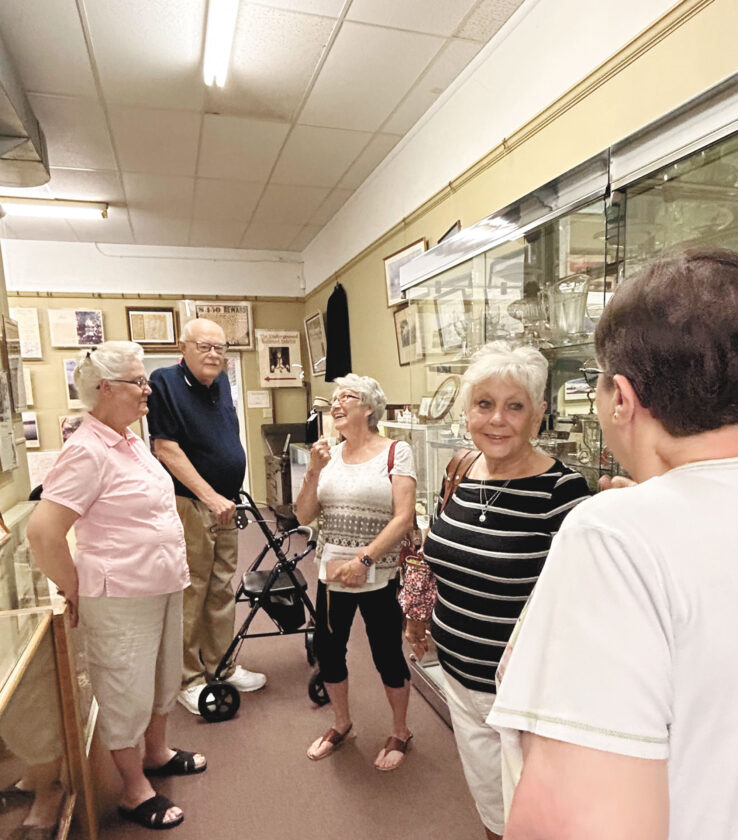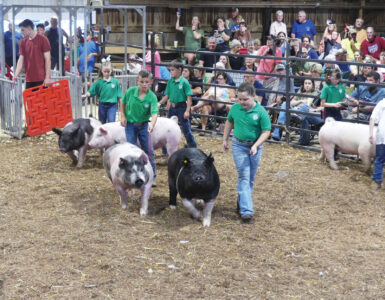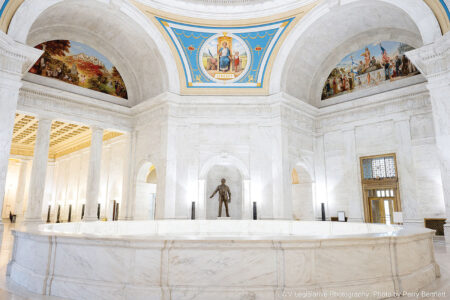Belpre museum holds open house in honor of Juneteenth

Reba Starner, former Belpre Mayor Bill McAfee, Judy Frum and Becky Copen compare notes and greet an additional visitor to the Underground Railroad Exhibit Room at The Farmer’s Castle Museum open house Saturday, commemorating the local history and significance of Juneteenth. The federal holiday is today. It has been a national observance since 2021, but has been celebrated within the Black community since 1866. (Photo by Nancy Taylor)
BELPRE — Awareness of Juneteenth and its significance to Washington and Wood County is slowly growing, according to Belpre Historical Society members Maggie Webster and Christopher Lohr.
The two work at The Farmer’s Castle Museum in Belpre and were there to host the museum’s second annual Juneteenth open house Saturday. The museum now houses a great portion of the area’s history from around 1815 to the 1860s in its Underground Railroad Exhibit, since the southern slave state of Virginia and its plantations were just an Ohio River away from the free state of Ohio.
The Emancipation Proclamation officially freed all enslaved people in the rebelling Southern states in 1863. On June 19, 1865, the Union’s army arrived in Galveston, Texas, to make sure the news got to the last part of the defeated Confederacy and to see that the President’s proclamation was enforced, even though it was two years or more after the fact.
The 13th Amendment to the U.S. Constitution officially made the abolition of slavery a national policy six months later when it was ratified by the required number of states in December 1865.
The reaction of the enslaved people in Texas who heard the news of June 1865 set the tone for Juneteenth celebrations of years to come. They immediately began to celebrate with prayer, feasting, song and dance, according to reports from that time.
Celebrations that have continued across parts of the United States into the 21st century typically include prayer, religious services, speeches, educational events, family gatherings and picnics.
As for the Belpre museum, in addition to the history that it houses, it’s a very short distance from the site of the relocated home of Col. John Stone at the corner of Blennerhassett Avenue and Stone Road (the house was moved from a spot closer to the river after it was flooded).
Today, the land between the Ohio River and one side of Blennerhassett Avenue is still largely open fields in the area in front of his house. Historical reports link Stone and those fields to an active part of the Underground Railroad.
An enslaved woman called “Aunt Jenny” was stationed on the Virginia side of the Ohio River at its confluence with the Little Kanawha River. She was to blow her foghorn to signal boats docking there, which was near the slave auction block in the public square area near the Wood County, Virginia, courthouse. But Aunt Jenny also used the horn to alert abolitionist Stone when fugitives were crossing from Parkersburg to Belpre.
Once on the Ohio side, they would hide in his corn fields, across from his house, until he could move them. In Little Hocking, eight miles downriver from Belpre, the enslaved people who were escaping looked for a lantern signal to guide them.
At Constitution, six miles upriver, Judge Ephraim Cutler listened to hoot owl calls to tell him there was a river crossing. There were Underground Railroad stations at Barlow, Bartlett, Tunnel, Marietta, Palmer, Newport, Vincent and other nearby places, as well.
The map of the routes looks like a piece of loosely knit lace at first glance, lots of space between stations, lots of rural land that still bordered on “nowhere.” But these communities helped to connect a rescue system that ran all the way to Canada without phones, internet or automobiles.
Lohr from the Farmer’s Castle Museum points out that an amazing and beautiful part of the Underground Railroad’s success was carried out in this area as entire communities — not just individuals — were of one mind. Everyone in the area of an active Underground Railroad station knew what was happening, even if they weren’t directly involved.
It was work that had to be done. And so it was.
That remains part of the pride and joy that can be learned and remembered on Juneteenth.
Nancy Taylor can be reached at ntaylor@newsandsentinel.com
***
Reporter’s note: The historical information from this story came from the Ohio History marker in front of the Farmers Castle Museum; conversations with Belpre Historical Society members Christopher Lohr and Maggie Webster; printed materials on display in the Underground Railroad Exhibit room of the museum; background from the website of the National Underground Museum in Cincinnati; and the legacy of local Black historian, author and lecturer Henry Burke, who recorded many essential details about the area’s history. Two of Burke’s books can be purchased at the museum.






